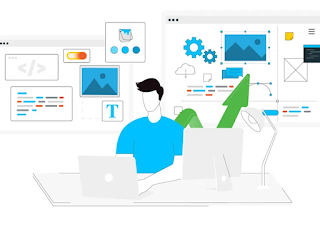AI in Web Design: 10 New Trends Shaping the Future of Digital Experiences
AI is bringing major changes to web design since AI makes the design of the web more dynamic, personalized, and efficient. Here are 10 key AI-driven trends that are revolutionizing the future of web design:
1. AI-Powered Design Tools
Designing a whole website using artificial intelligence platforms like Wix ADI and Bookmark’s AIDA is possible. The following tools enable individuals to create websites even if they do not know about graphic design, the domain of AI in web design expands to citizens. These tools scan through user inputs and can output design forms that are compatible with the user’s tastes.
2. Automated Personalization
AI is being used to personalize the website experience to the extent of the traffic and behavior of the users. For example, AI systems can record how users engage with website content and then set content, images, and layouts in motion. This therefore leads to more interesting and compelling visits from the visitors resulting in happy customers.
Example: Applications such as Dynamic Yield assist websites in delivering content, recommendations as well as special offers using the users’ browsing patterns.
3. Voice User Interfaces (VUI)
As more people use smart voice assistants, such as Siri, Alexa, or Google Assistant, it is becoming typical to create sites with voice commands. With advancements in AI, VUIs are continually shifting to become easier to use and allow users to explore websites using voice commands, which makes it easier to use a website.
4. AI-Driven Content Generation
Copy.ai and Jarvis are some of the programs that are fueling the creation of quality web content. It uses natural language processing (NLP) to generate text for landing pages, blogs, and product descriptions. These tools help manage content creation, taking away some pressure from writers and at the same time, making sure search and users are considered.
5. Conversational Chatbots and AI Assistants
Chatbots have gone from being basic text-based automated programs or a tools to complex AI-enabled one that offers real-time services. Applying AI chatbots on websites is beneficial in serving customers since users want to solve their concerns and get solutions immediately.
Example: Drift and Intercom are some of the AI tools that make use of real human conversations and offer product strategies, answer questions, and enhance customer relations.
6. Responsive Design and Layout Optimization
AI is already being used to enhance the interaction of websites by providing dynamic layouts suitable for various display sizes. Machine learning can make smart decisions on how users behave on different devices and help make all the interfaces as smooth as possible, no matter if it’s for mobile, tablet, or PC.
Example: Even The Grid, the chosen site, relies on AI to decide on the layout, color, and typography for any device the site will be viewed on.
7. AI-Powered SEO Optimization
Today AI is being used in SEO for designers to come up with websites that will fetch better results on results pages. There is plenty of AI tools available starting from Surfer SEO and MarketMuse which helps to scan the structure and content of web pages and provide recommendations on how to enhance SEO results. These tools assist web designers in comprehending what a keyword means, how to establish proper content redistribution, and its effectiveness in the SEO ratings.
8. Visual Recognition and AI-Enhanced Image Editing
AI is improving the extensive utilization of images in webpage architecture. Thanks to AI, Remove. Bg and Let’s Enhance help designers remove backgrounds automatically, upscale images, or enhance the quality of visuals. This cuts down on the amount of time it would take to correct the images manually, making the user engagement much better through quality images.
Visual Recognition: Image recognition and the classification of pictures of objects makes it possible for sites to display more relevant content as well as visual data according to user preference.
9. Predictive User Behavior Analytics
Artificial intelligence is revolutionizing the way websites monitor and forecast customer habits. From data, AI systems can derive which next action a user is most likely to perform, like clicking on a button, making a purchase, or leaving the site. It enables designers to offer better user paths and enhances the chances for the user to make a purchase.
Example: Hotjar and Crazy Egg both entail artificial intelligence to analyze heatmaps and the behavior of users needed in perusing website and its improvements.
10. AI-Based Security Enhancements
It is also very important to note that AI is also being utilized to develop stronger and heighten website security. It has also proved that AI is capable of defining patterns that denote security threats and potential malicious like bots, malware, hacking attempts, DDoS, and so on. In this way, AI assists in preventing website and user data leaks because all potential threats are assessed ahead of time.
Example: Cloudflare employs the use of artificial intelligence to determine some activities as malicious, and hence, prevent such prohibited activities affects website users and their data.
Conclusion
At Projecttree, AI is not simply making web appearances more sophisticated; it’s changing the whole concept and process by automating it, customizing the content, and optimizing the users’ interaction. From conversation bots to unique GUI features, AI is changing the very way we consider designing sites of the future. It will also predict the development of still newer and advanced IA techniques that would enhance the ease, effectiveness, and utility of the web.




Comments
Post a Comment